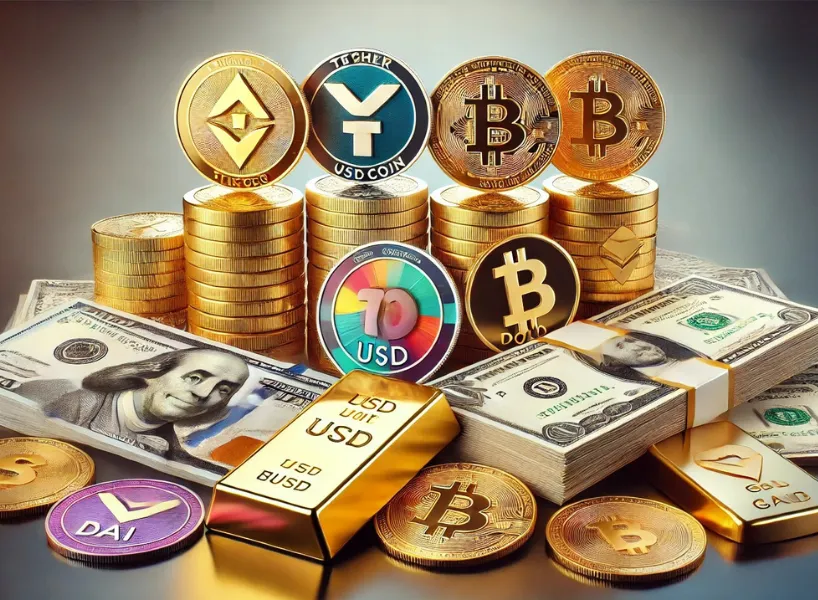In the highly volatile cryptocurrency market, the Stablecoin is like a pin in the ocean, said to stabilize value and facilitate trading. But is it really as stable as its name suggests? Follow us today! techduker Let's talk about the types of stablecoins and how they work!
Stablecoins areWhat's that??
Stable Coin is a price-stabilized currency.Encryption CurrencyThe amount of gold is usually linked to fiat currency or other stabilizing assets (gold).
For example, the dollar-backed Tether (USDT)The target value is always $1. Compared to the highly volatilebitcoin (virtual currency)Stabilized currencies are more suitable for daily payments, storage of value and cross-border transactions.
Simply put, the cryptocurrency market is highly volatile and it is not uncommon for prices to fluctuate dramatically within a short period of time.
Combining the stability of a legal tender with the transparency of blockchain technology, stablecoin demonstrates its stabilizing effect in scenarios such as transaction pricing, hedging, and cross-border payments, bringing more security to a volatile market.

What are Stabilized Coins? The three main types of Stabilized Coins
- Centralized Asset-Backed Stabilized Currency
- These stablecoins use fiat currency (e.g. USD) as a reserve asset to ensure value stability. An example is USDT,USDC etc. The value of these stabilized currencies is backed by U.S. dollar reserves and is regularly audited by a third-party custodian to ensure transparency and compliance.
- Digital Asset Backed Stabilized Currency
- Such stablecoins use other cryptocurrencies as collateral, but are often overcollateralized due to the high volatility of cryptocurrencies. For example, MakerDAO's DAI may need to collateralize $2,000 worth of Ether to issue $1,000 worth of stablecoins to cope with market volatility.
- Non-Asset-Backed Stabilized Currency (Algorithmic Stabilized Currency)
- These stablecoins are not backed by any physical assets, but rather by algorithms that control the supply of tokens to stabilize the price. Basis, for example, mimics central bank management of fiat currency supply by regulating liquidity through smart contracts.
Extended Reading:Best Cryptocurrencies to Buy Now - Top 10 Cryptocurrency Recommendations for 2024
Stabilized Coin Principle
Stabilized coins are able to maintain their value stability mainly by relying on the design mechanism behind them. The following are common operating principles:
- Principles of Asset Mortgages
- The value of a stablecoin is usually backed by physical assets such as US dollars, gold or other commodities. These assets act as collateral reserves to ensure that the value of the stable money is pegged to the fiat currency. When market demand fluctuates, the issuer can stabilize the value of the currency by regulating the reserve assets.
- Over-collateralization mechanism
- Some stabilized currencies have been made available through overcollateralized cryptocurrencies (such as theEtherThe Stabilized Currency is used to maintain stability. For example, issuing a $1,000 stablecoin with $2,000 worth of cryptocurrency as collateral will maintain the value of the stablecoin even if the market price fluctuates.
- Algorithmic Regulation Principle
- The supply of stable money is automatically adjusted by an algorithm that does not require an asset reserve. For example, when market demand increases, the system will issue more stablecoins, and conversely, it will withdraw some stablecoins in order to maintain exchange rate stability with the fiat currency. This approach mimics the monetary policy of a central bank, but is automatically implemented by smart contracts.
Maispin 邁斯娛樂城 首儲送50%
- USDT deposit and withdrawal is super fast, official certification, safe and reliable!
- High privacy, no bank account required
- Cashback 0.4% - 1%, No Running Water Limit
- Universal Affiliate up to 0.4%, earn your commission rewards!

The Importance of Stabilized Currency
Stablecoin is the cornerstone of the cryptocurrency market, which solves the pain point of the highly volatile cryptocurrency market by efficiently combining price stability with blockchain technology.
In exchanges, Stablecoins act as a bridge between fiat and cryptocurrencies, dramatically improving the efficiency of capital flows, and in times of market volatility, Stablecoins become the preferred tool for investors to hedge their bets and preserve their value.
In addition, the stable currency has expanded the payment and cross-border transaction landscape, becoming part of the global financial infrastructure through its low cost and high efficiency.
It can be said that stablecoins not only support the operation of the entire crypto ecosystem, but also bring opportunities for innovation and change to the traditional financial system.
Functions of Stabilized Currency
Stablecoins have several important functions in the cryptocurrency market, and these functions make them one of the indispensable digital assets:
- Bridge for French currency deposits and withdrawals
- Stablecoins quickly exchange cryptocurrencies with fiat currencies, providing easy money movement, especially in exchanges.
- Risk Avoidance Function
- When the market fluctuates significantly, investors can switch their funds to stable currency to reduce the risk of loss and realize short-term preservation of capital.
- Cross-border payment instruments
- With low cost and speed, stable currency payments are more efficient and affordable than traditional bank transfers for cross-border transactions or remittances.
Extended Reading:What is decentralization? Why decentralization is the soul of blockchain?
Stabilized Coin FAQFAQ
Q1. Is stable money really stable?
The stability of a stablecoin depends on the asset-backed or algorithmic mechanism behind it. The price of a stablecoin may fluctuate if there is an insufficient reserve of assets backing its value or if the algorithm fails. Therefore, transparency and compliance should be recognized when choosing stable money.
Q2. What is the difference between Stablecoin and Bitcoin or Ether?
The prices of cryptocurrencies such as Bitcoin and Ether are subject to market supply and demand and are more volatile. Stabilized currencies are designed to maintain value stability and are usually pegged to fiat currencies such as the U.S. Dollar, making them more suitable for use as a medium of exchange or a store of value.
Q3. How does the Stabilized Currency remain pegged to the fiat currency?
The stabilization of the value of the Stabilized Currency relies primarily on the following methods:
- Assets collateral: Secured by U.S. dollars, gold or other physical assets.
- overcollateralization: Use more cryptocurrencies as reserves to cope with market volatility.
- algorithmic control: Maintain price stability by regulating supply.
Q4. What are the risks of using stablecoins?
The risks of stabilizing the currency include:
- Reserve Transparency: Trust may be compromised if the issuer cannot demonstrate sufficient reserve assets.
- Compliance Risks: Some stabilized currencies may not comply with local financial regulations and face regulatory problems.
- Smart Contract Vulnerability: There may be technical vulnerabilities in smart contract-based stablecoins.
Q5. Can stabilized currency completely replace legal tender?
At present, stablecoins are used more as a supplement to fiat currencies, especially in cross-border payments and cryptocurrency transactions. To fully replace fiat currencies, stablecoins still need to address issues such as regulation, trust and popularity.
Q6. Can I earn money with Stablecoins?
Yes, Stablecoins can earn money! By depositing Stablecoins into the DeFi platform's liquidity pool or lending system, you can earn fixed or variable returns. However, you need to be aware of the risks of smart contract vulnerabilities, platform issues, etc. It is important to choose a reputable platform and evaluate it carefully.
Q7. Will stable currencies crash?
The likelihood of a collapse of a stablecoin depends on its operating mechanism and the reliability of its asset backing. When a stablecoin's reserve assets are insufficient, less transparent, or when market confidence collapses, it may result in a price delinking. For example, some algorithmic stabilized currencies have experienced price collapses due to imbalances between supply and demand. Therefore, special attention should be paid to the underlying asset collateral and management transparency when choosing a stablecoin.
Q8. Is stable money safe?
The security of stabilized coins depends mainly on the following factors:
- Safety of Reserve Assets: Stabilized currency reserve assets are relatively safer if they are held in trust by a reliable institution and audited regularly.
- Smart Contract Security: Stablecoins based on the operation of smart contracts may be exposed to the risk of technical vulnerability, which requires checks by auditing organizations and technical safeguards by the platforms.
- Regulatory Compliance: Regulated stablecoins are usually safer because they are subject to strict legal requirements and audits.
Although the overall security of stablecoins is higher than that of other cryptocurrencies, users still need to pay attention to choosing stablecoins with credibility and transparency, as well as diversifying risks.
Q9. Is the interest rate of stable money high?
The annualized percentage yield (APY) of stablecoins is usually 3% ~ 20%. Through pledging, you can get a much higher return than traditional bank deposits, but the high return comes with risks, such as smart contract vulnerabilities, platform operation problems and possible losses from market volatility. Therefore, it is recommended to choose a deposit account such as Aave,Compound We have pledged on well-known and compliant platforms, and have done a good job of risk assessment to ensure that the returns are robust and safe.
Maispin 邁斯娛樂城 首儲送50%
- USDT deposit and withdrawal is super fast, official certification, safe and reliable!
- High privacy, no bank account required
- Cashback 0.4% - 1%, No Running Water Limit
- Universal Affiliate up to 0.4%, earn your commission rewards!
